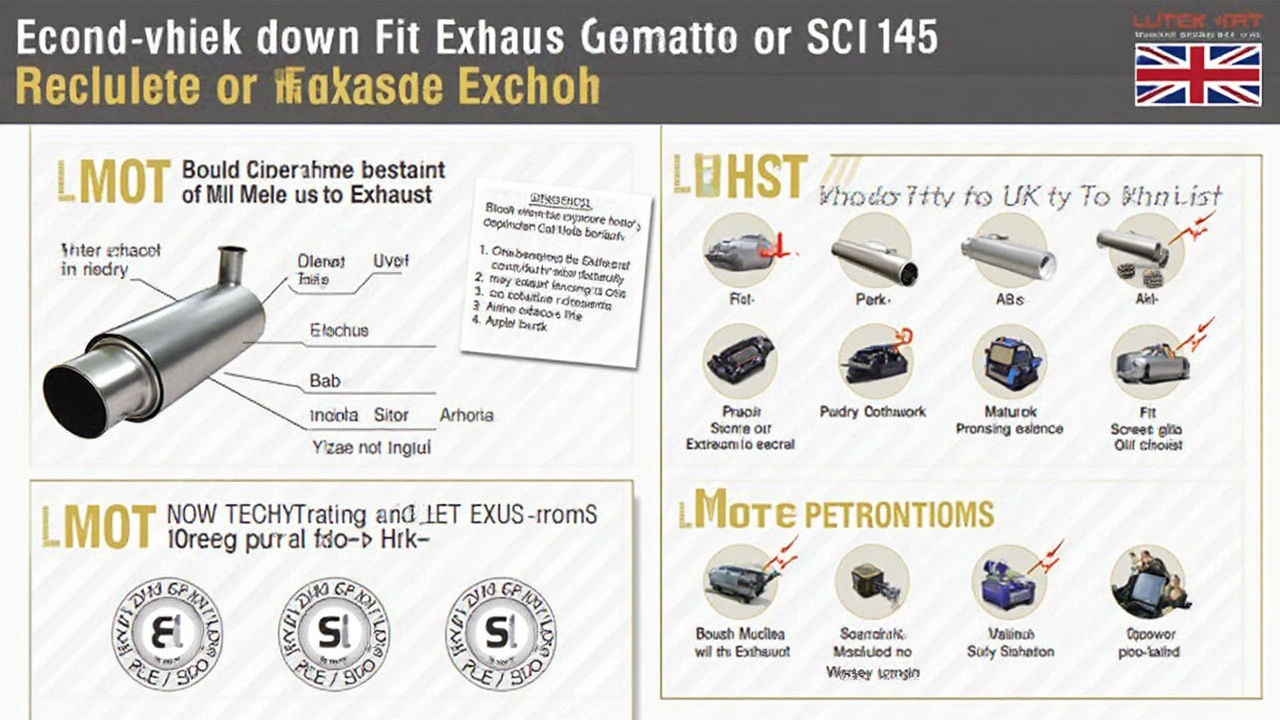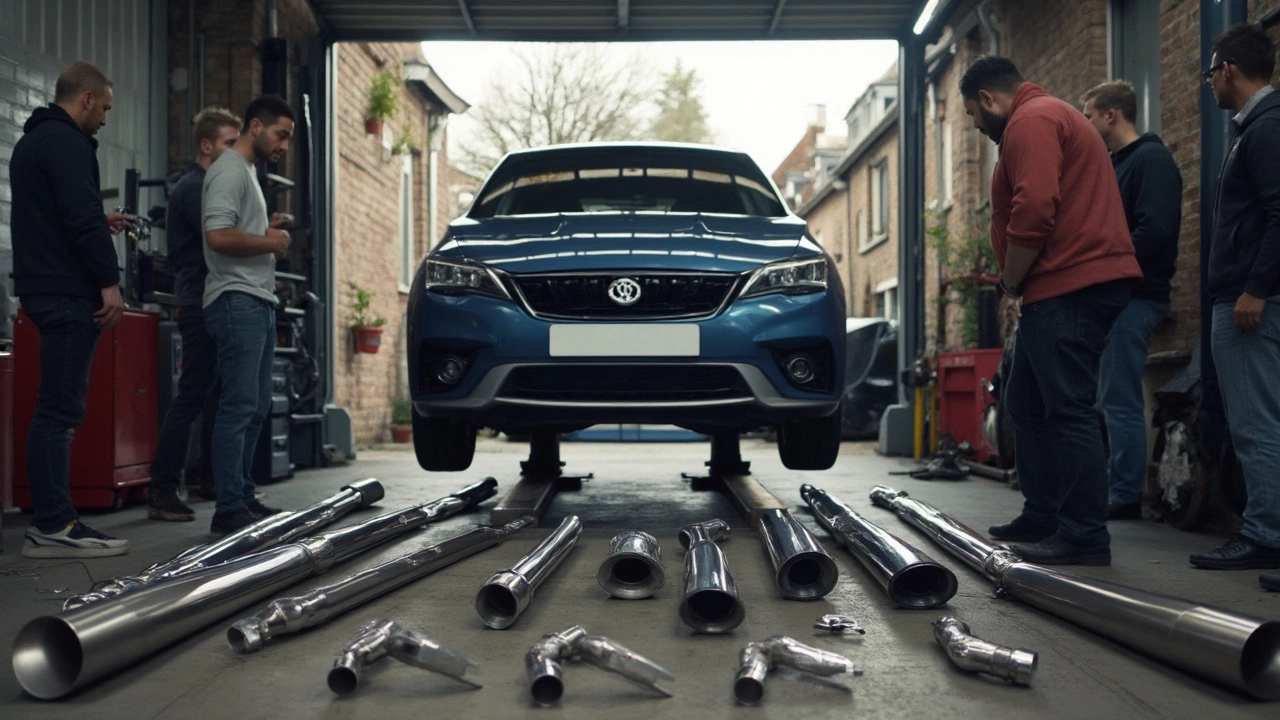Ever had your head turned by the deep growl of a passing car or the sporty rasp at a set of lights? You’re not alone. If you’re eyeing up a new exhaust, whether it’s for a cheeky power boost or just for that adrenaline sound, it’s easy to get caught up in the noise—literally. But, before handing over any cash, it pays to know what you’re actually getting into. Not all exhausts are created equal, and a hasty buy could mean wasted money or, worse, run-ins with the MOT tester. Ready to avoid those embarrassing mistakes? Let’s get stuck into what really matters when picking out an exhaust, whether you drive a three-year-old Fiesta or a beloved classic BMW.
Understand the Real Benefits and Pitfalls of an Exhaust Upgrade
Everyone loves a bit of extra bhp and a soundtrack to match, but there’s more to exhausts than meets the ear. Swapping your standard exhaust for an aftermarket one isn't always about pure power. First thing’s first, ask yourself: What’s the actual point for you? Are you after style, sound, efficiency, or flat-out performance? Understanding this will shape every choice you make.
Performance gains from an upgraded exhaust often get hyped, but don’t be fooled into thinking you’ll get 20 more horsepower just by swapping a backbox. The most legitimate improvements come when you upgrade the whole system—think headers, mid-pipe, and backbox—especially when combined with intake tweaks and a remap. If you just bolt on a shiny tip, the difference is often more bark than bite. According to a test from Car Throttle, some aftermarket cat-back exhausts on stock cars barely added 3-5hp—hardly earth-shattering. And let’s not forget fuel economy: a less restrictive system can help a little here, sure, but drive with your foot down enjoying your new sound and you'll likely use more petrol, not less.
Reliability can also take a hit if you cheap out. Lower-end systems rust out quickly in our UK climate; road salt, rain, and grit are relentless on mild steel. Stainless steel holds up hugely better, especially 304 or 409 grades. Titanium is lighter and stronger again, but is typically found in racing or enthusiast builds due to its eye-watering price. And don’t get caught up in brands alone—a pretty logo isn’t a guarantee of quality. It’s the specification and construction that matter.
Sound is the next big factor. Not all exhausts sound the same, and it’s not just about being ‘louder’. Listen to sound clips online, but trust your ears in person if you can. Some systems sound throaty and refined; others are raspy, boomy, or droney at motorway speeds—a quick way to ruin a road trip. There’s nothing worse than buying an exhaust you hate after 50 miles, or after your neighbours start shooting you dagger eyes every time you pull up.
And, let’s be honest—legalities can’t be ignored. The DVSA and MOT testers are cracking down on loud exhausts and anything that deletes emissions components like catalytic converters. UK law says road-going cars must have all their cats and silencers unless they rolled out of the factory without them. Police have devices and will fine you on the spot if your car exceeds the legal noise limit (74 decibels, for the MOT, measured 0.5m from the tailpipe). That’s less than you think. Keep it street-legal unless you really want to play exhaust roulette.
Fitment is another headache if you aren’t careful. Some universal systems sound good on paper but need hacking up brackets, welding, or bodging to fit. Nothing like crawling under your car in the rain to remind you why proper fitment—OEM-like or well-reviewed kits—matters. Always check compatibility for your car’s exact year, make, and model; small differences make installs a nightmare, especially if you’re working on your driveway rather than a lift with all the right tools.

Key Features and Specs You Should Weigh Up
Material is one area where you get what you pay for. Stainless steel, as mentioned earlier, is the go-to for daily drivers in the UK, resisting rust with much more determination than mild steel. If you spot a deal on titanium, be sure your wallet is ready—it’s featherlight and ultra-strong but easily three times the cost. On the other end, aluminium-coated steel is cheap, light, and ok for track toys, but might last only a few salty winters before holes show up.
Pipe diameter can make or break your driving experience. Too narrow, and you strangle the engine; too wide, and you kill torque and end up noisy with sluggish response. As a ballpark, 2.25–2.5 inches suits most small to mid-sized engines, while bigger turbocharged or V6/V8 motors want 3 inches or more. Check owner forums or reputable tuners for your exact car—they’ve nearly always argued about this and can share their results.
The shape and type of exhaust tip grabs most people’s attention, but it affects fitment and sound shape, too. Rolled tips mellow the noise, while slash-cut or twin tips often make things a bit raspier and sharper. Cerakote or chrome finishes resist corrosion, but they do age, and frequent cleaning is a must if you want your pride and joy to look fresh rather than battered after one winter.
Baffles and silencers are worth investigating. Many aftermarket exhausts let you remove or adjust these—handy if you want to swap between daily driving and track mode. Beware: some removable baffles are fiddly or rattle annoyingly at certain revs. Quality brands like Milltek, Scorpion, and Cobra often have tried-and-tested designs that work in the real world, so dig into reviews if you want to dodge disappointment.
If you want to go the custom route, many local exhaust shops in places like Manchester or Birmingham will fabricate whatever you fancy, often for less than an off-the-shelf brand. This is especially handy for older cars or unique projects—think a 1989 MX-5 with quirky mounting points. Ask to see previous work before you pay anything. Decent welds and smart routing matter more than paint or a flash tip.
The weight of your exhaust can also impact performance. Lighter systems take stress off the rear axle and, for keener drivers, actually change the handling feel a little, especially in lightweight cars. Most road drivers might not notice, but if you want every ounce of performance (say you track your car), shedding kilos from a heavy OE system is no bad thing. But, don’t ditch insulation if you drive a lot; cheap systems often skip heat shields, making your cabin noisier and possibly causing hotspots near the exhaust tunnel or under rear seats.
If emissions are a concern—or you want to keep resale options open—don’t remove the catalytic converters unless you’re prepping for a closed course. High-flow cats offer a legal way to boost performance a smidge without running foul of the MOT. Some cars throw a ‘check engine’ light with aftermarket systems, especially if sensor placement changes, so read up on your car’s quirks before you buy. Swapping O2 sensor locations is not a job for the faint-hearted.
Warranty is easily forgotten, but it matters. A reputable aftermarket system should offer a solid warranty—ideally lifetime for major brands. This covers against cracking, rattles, and weld failures, which can and sadly do happen, especially on cars that live outside and on salted winter roads. Keep your receipts and always register your warranty, because who wants to pay again to fix a rattly exhaust after a cold snap?
Cost matters, but so does value. You can spend £150 on something basic, or £2,000+ on a top-of-the-line system. Just make sure you’re buying the right thing for your needs. Ask yourself: do you daily drive, or is it a fair-weather just-for-fun machine? A reliable daily needs quieter, corrosion-resistant options with robust support. If you’re just after some fun once a week, maybe go wild with a one-of-a-kind custom job. Just don’t buy solely on YouTube hype—half the time those cars are sponsored or modded beyond what most people want to live with day to day.

What to Check Before Pulling the Trigger: Tips and Mistakes to Dodge
Ready to grab that new exhaust? Hit pause and check a few more things. Ask for real user feedback, not just Amazon reviews. Forums dedicated to your car are goldmines; don’t skip reading the long threads—chances are someone’s already dealt with any weird noises, fitment issues, or unexpected MOT fails from a particular setup.
If you’ve got access to car meets or local gatherings, chat to owners and get a listen in real life. The noise you hear through your phone often doesn’t match what you get with your ears in person, especially with mic distortion. Plus, you might find installation or cost-saving tips along the way. Don’t underestimate the wisdom of that guy who’s swapped three exhausts already.
Before buying, double-check the return policy. Even the best brands slip up now and then, and you don’t want to get stuck with a part that doesn’t fit. Some retailers are hopeless at customer service, especially with “special order” systems—these can be near impossible to return for a refund if the box is opened, so check those small print details before clicking ‘buy’.
Installation can be straightforward or a Saturday-ruining ordeal. If you’re DIY-ing it, make sure you’ve got proper jack stands, a breaker bar, and plenty of WD-40. Rusted nuts and bolts rarely play nice, especially on older cars. If paying a pro, ask for an all-in quote and confirm if they’ll fix any issues if something rattles or leaks after a few days.
If you’re lucky enough to still have your factory system in decent shape, hang onto it. Even if your new exhaust makes you grin, factory parts can be a lifesaver come MOT time or when selling the car. Originality has become way more important for resale value, especially with collector models and Japanese imports—the car market loves a genuine example.
Keep an eye out for hidden costs. Fitting kits, new gaskets, exhaust hangers, or upgraded mounts can push the bill higher. Some online sellers bundle these; others don’t mention them at all. Double-check or ask up front. No one likes being halfway through an install and realising you’re missing £30 of rubber rings.
If you’re worried about insurance, call your provider before fitting anything. Even a backbox swap can count as a ‘modification’ and not declaring it is a fast-track to a void policy. Most companies in the UK are fine if you let them know, but premiums can creep up, especially for younger drivers or hot hatches.
Last thing—if you’re going to the trouble, enjoy the process. Take before and after videos, listen for the subtle changes as the exhaust settles in (they often do get a bit louder after a couple of weeks), and share your results. Car groups thrive on this stuff, and you might just help the next person avoid a blunder.
So, when you’re eyeing up that new buying an exhaust kit, remember: a little research saves a lot of hassle. Get the right material, make sure it actually fits, double-check the noise is what you want, think about the legal side, and keep your expectations realistic. Do that, and you won’t just have a louder car—you’ll have a better one, too.

